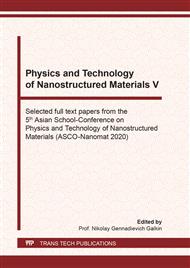[1]
M. Jung, S. G. Ji, G. Kim, and S. Il Seok, Perovskite precursor solution chemistry: From fundamentals to photovoltaic applications,, Chem. Soc. Rev., vol. 48, no. 7, p.2011–2038, (2019).
DOI: 10.1039/c8cs00656c
Google Scholar
[2]
S. Il Seok, M. Grätzel, and N. Park, Methodologies toward Highly Efficient Perovskite Solar Cells,, Small, vol. 14, no. 20, p.1704177, (2018).
DOI: 10.1002/smll.201704177
Google Scholar
[3]
K. Lin et al., Perovskite light-emitting diodes with external quantum efficiency exceeding 20 per cent,, Nature, vol. 562, no. 7726, p.245–248, (2018).
DOI: 10.1038/s41586-018-0575-3
Google Scholar
[4]
D. Gets et al., Light-emitting perovskite solar cell with segregation enhanced self doping,, Appl. Surf. Sci., vol. 476, no. 2018, p.486–492, (2019).
DOI: 10.1016/j.apsusc.2019.01.031
Google Scholar
[5]
L. Gil-Escrig et al., Efficient photovoltaic and electroluminescent perovskite devices,, Chem. Commun., vol. 51, no. 3, p.569–571, (2015).
DOI: 10.1039/c4cc07518h
Google Scholar
[6]
H. Kim et al., Peroptronic devices: perovskite-based light-emitting solar cells,, Energy Environ. Sci., vol. 10, no. 9, p.1950–1957, (2017).
DOI: 10.1039/c7ee01666b
Google Scholar
[7]
D. Gets et al., Dipolar cation accumulation at interfaces of perovskite light emitting solar cells,, arXiv:1910.12285.
Google Scholar
[8]
Mojtaba Abdi-Jalebi et al., Potassium- and Rubidium-Passivated Alloyed Perovskite Films: Optoelectronic Properties and Moisture Stability,, ACS Energy Lett., 3, 11, 2671-2678, (2018).
DOI: 10.1021/acsenergylett.8b01504
Google Scholar
[9]
Guangru Li et al., Efficient Light-Emitting Diodes Based on Nanocrystalline Perovskite in a Dielectric Polymer Matrix,, Nano Lett., 15, 4, 2640-2644, (2015).
DOI: 10.1021/acs.nanolett.5b00235
Google Scholar
[10]
Jae Choul Yu et al., Effect of perovskite film morphology on device performance of perovskite light-emitting diodes,, Nanoscale,11, 1505-1514, (2019).
DOI: 10.1039/c8nr08683d
Google Scholar
[11]
Yanliang Liu et al., Dual-functional light-emitting perovskite solar cells enabled by soft-covered annealing process,, Nano Energy 61 251–258, (2019).
DOI: 10.1016/j.nanoen.2019.04.067
Google Scholar
[12]
Zhengguo Xiao et al., Solvent Annealing of Perovskite-Induced Crystal Growth for Photovoltaic-Device Effi ciency Enhancement,, Adv. Mater. Vol. 26, Issue 37, 6503-6509, (2014).
DOI: 10.1002/adma.201401685
Google Scholar
[13]
Feng Wang et al., Defects engineering for high-performance perovskite solar cells,, npj Flexible Electronics vol. 2, Article number: 22, (2018).
Google Scholar
[14]
Baohua Wang et al., Crystallinity and Defect State Engineering in Organo-Lead Halide Perovskite for High-Efficiency Solar Cells,, J. Mater. Chem. A,4, 3806-3812, (2016).
DOI: 10.1039/c5ta09249c
Google Scholar
[15]
Jiang Liu et al., Improved Crystallization of Perovskite Films by Optimized Solvent Annealing for High Efficiency Solar Cell,, CS Appl. Mater. Interfaces, 7, 43, 24008-24015, (2015).
DOI: 10.1021/acsami.5b06780
Google Scholar
[16]
J. Clay Hamill Jr. et al., Influence of Solvent Coordination on Hybrid Organic–Inorganic Perovskite Formation,, ACS Energy Lett., 3, 1, 92-97, (2018).
DOI: 10.1021/acsenergylett.7b01057
Google Scholar


